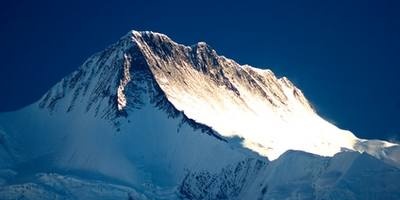|
 The Himalayas are an amazing mountainous country with unique natural conditions. On the side of the mountain, the subtropical evergreen forest turns into temperate deciduous forests. This belt is spread from 2000 to 3000 m. Here you can see how the belt of deciduous forests covers the top of the first ridge. Above is the belt of coniferous forests, which is dominated by silvery spruce, fir, larch, tugs. The Himalayas are an amazing mountainous country with unique natural conditions. On the side of the mountain, the subtropical evergreen forest turns into temperate deciduous forests. This belt is spread from 2000 to 3000 m. Here you can see how the belt of deciduous forests covers the top of the first ridge. Above is the belt of coniferous forests, which is dominated by silvery spruce, fir, larch, tugs.
The upper border of the forest in the Himalayas runs at an altitude of 3500 m. From an altitude of 3500 m up to the border of eternal snow, an alpine zone with subalpine and alpine vegetation, shrubs and lush meadows extends. Among the shrubs, rhododendrons are widespread here. Their flowers come in a wide variety of colors - white, blue, red, blue, yellow, pink.
The vegetation of the alpine meadows consists of brightly colored blue, red, yellow, purple primroses, gentians, buttercups, anemones, edelweiss.
In the Himalayas there is the highest peak of the globe - Chomolungma with a height of 8850 m. The Himalayas stretch in the form of a huge arc, more than 2400 km (the distance from Crimea to the shores of the White Sea), with an average width of 200-300 km, occupying an area of about 650,000 square meters. km. A huge arc of the Himalayas in the northwest approaches the Karakorum ridge and the Pamir Highlands, and in the west it joins the Hindu Kush mountains. In the east, the Himalayas pass into the meridional ridges of Burma.
The Himalayas are young folded mountains. They arose on the site of the Tethys sea basin, which connected the seas of Southeast Asia with the Mediterranean Sea of Europe. The mountains were formed in the Tertiary and early Quaternary periods.
Mountain building continues to this day, as evidenced by frequent earthquakes. Some earthquakes are accompanied by numerous cracks, faults, shears, and the formation of lakes. For example, in August 1950, a catastrophic earthquake was noted in Assam, as a result of which the channels of many rivers changed, roads, bridges and more than one hundred thousand buildings were destroyed. The earthquake coincided with the flooding of the Ganges, Brahmaputra and their tributaries. In the valley of the Brahmaputra River, geysers clogged, and the river surface was covered with blackish layers of oil and asphalt. Thousands of villages were flooded. Hundreds of thousands of people died.
 The mountainous arch of the Himalayas, flanking the Indian subcontinent from the north, is almost insurmountable for the invasion of cold air from Central Asia. During the summer monsoon, the Himalayas retain moist air masses from the Indian Ocean. Especially a lot of precipitation falls on the southern slopes of the Eastern Himalayas. So, for example, in Cherrapunji, in the wettest place in the world, about 12,000 mm of precipitation falls per year. The mountainous arch of the Himalayas, flanking the Indian subcontinent from the north, is almost insurmountable for the invasion of cold air from Central Asia. During the summer monsoon, the Himalayas retain moist air masses from the Indian Ocean. Especially a lot of precipitation falls on the southern slopes of the Eastern Himalayas. So, for example, in Cherrapunji, in the wettest place in the world, about 12,000 mm of precipitation falls per year.
The large amount of precipitation on the southern slopes of the Himalayas affected not only the density of the river network, but also the richness and diversity of vegetation.
Traveling through the tropics of Asia at the end of the 19th century, the famous Russian botanist and geographer A. N. Krasnov gave the following description of terai: “First, fan palms appear at the foot of the slopes, then, with increasing terrain and increasing humidity, manga and tall spreading bamboo appear in terai, faithful companion of the tropics; a broadleaf banana and a coconut tree also grow here. These plants are common in villages that nestle on hillocks among rice fields. The Himalayas, closed by foothills, are not visible from here. But their proximity dramatically affects the climate. Thick clouds here constantly envelop the slopes of the foothills. Below, on the plain, the air is saturated with moisture. The slightest drop in temperature in the upper atmosphere is enough to cause showers, which in May-June reach a terrible force.The fields are covered with water for several feet. Farming is temporarily discontinued, and residents of recent fields are engaged in fishing.
Terai serve as a refuge for tigers, wild buffaloes, and various reptiles. These forests are home to a valuable fat tree, giant bamboos, soap trees, mimosas, horse chestnuts, etc. The trees are intertwined with lianas. There is a climbing rattan palm, which is more than a hundred meters long.
Oksana Nikolaevna
|
 The Himalayas are an amazing mountainous country with unique natural conditions. On the side of the mountain, the subtropical evergreen forest turns into temperate deciduous forests. This belt is spread from 2000 to 3000 m. Here you can see how the belt of deciduous forests covers the top of the first ridge. Above is the belt of coniferous forests, which is dominated by silvery spruce, fir, larch, tugs.
The Himalayas are an amazing mountainous country with unique natural conditions. On the side of the mountain, the subtropical evergreen forest turns into temperate deciduous forests. This belt is spread from 2000 to 3000 m. Here you can see how the belt of deciduous forests covers the top of the first ridge. Above is the belt of coniferous forests, which is dominated by silvery spruce, fir, larch, tugs.




